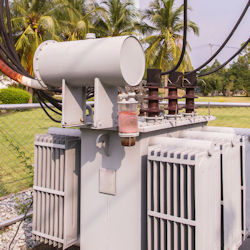Case Study
A 20-year-old male laborer was carrying a 20-foot piece of iron from a welding shop to an outside storage rack.
As he was turning a corner near a bank of electrical transformers, the top end of the piece of iron struck an uninsulated supply wire at the top of a transformer. Although the transformers were surrounded by a 6-foot fence, they were about 3 feet taller than the fence enclosure. Each transformer carried 4,160 volts. When the iron hit the supply wire, the laborer was electrocuted. A forklift operator heard the iron drop to the ground at about 8:46 a.m. and found the victim 5 minutes later. He was pronounced dead on arrival at a local hospital.
Findings:
- According to OSHA 1926.403(j)(2): Enclosure for electrical installations. Electrical installations in a vault, room, closet or in an area surrounded by a wall, screen, or fence, access to which is controlled by lock and key or other equivalent means, are considered to be accessible to qualified persons only. A wall, screen, or fence less than 8 feet (2.44 m) in height is not considered adequate to prevent access unless it has other features that provide a degree of isolation equivalent to an 8-foot (2.44-m) fence. The entrances to all buildings, rooms or enclosures containing exposed live parts or exposed conductors operating at over 600 volts, nominal, shall be kept locked or shall be under the observation of a qualified person at all times.
Knowledge Check Choose the best answer for the question.
6-4. A wall, screen, or fence around electrical installations must provide a degree of isolation equivalent to _____.
You forgot to answer the question!

